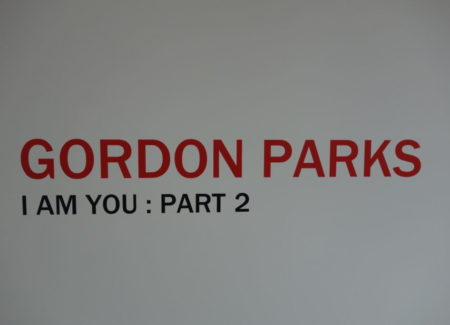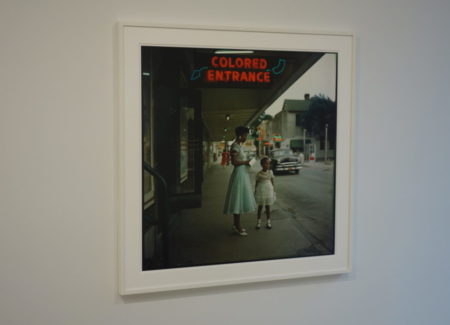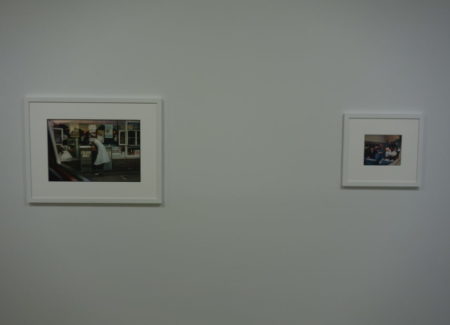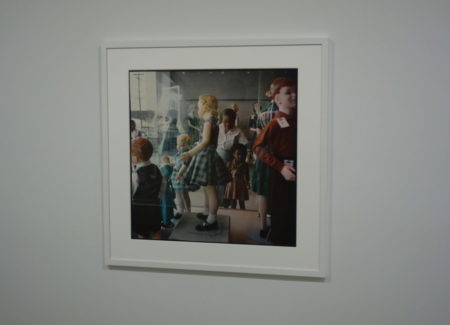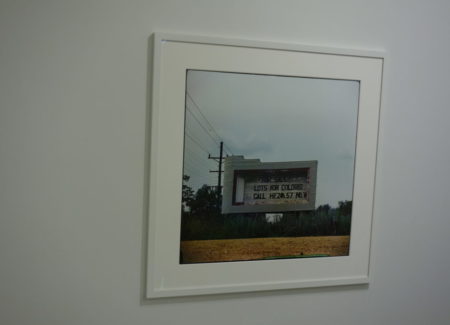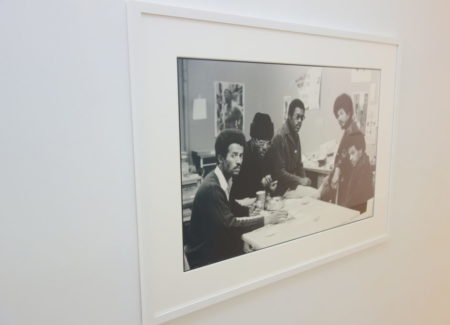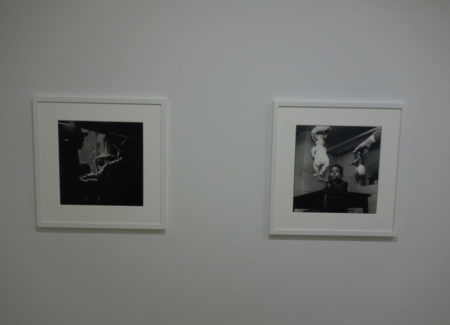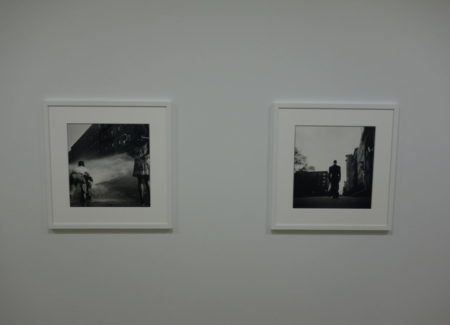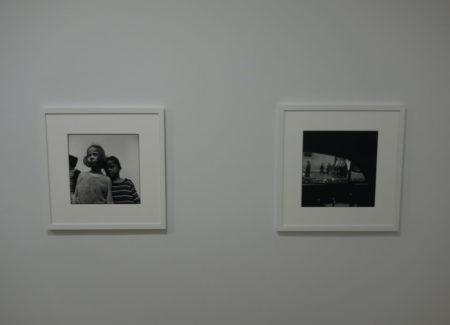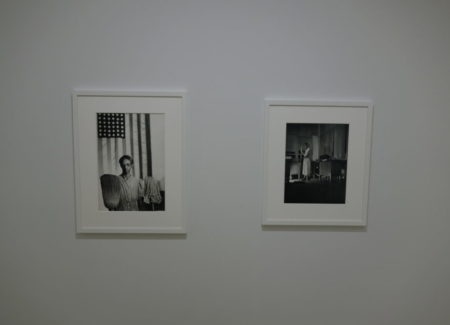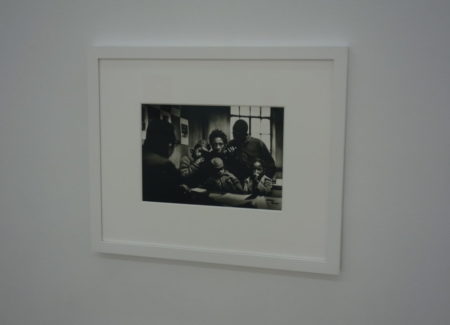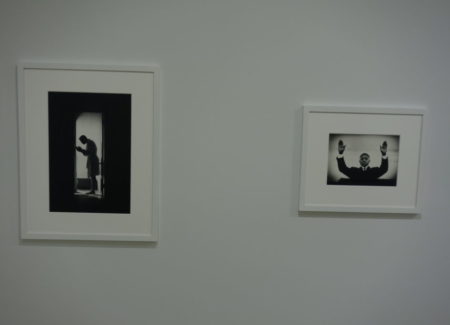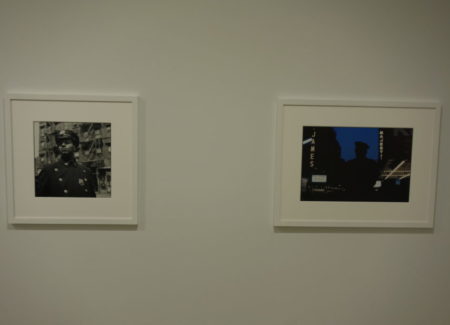JTF (just the facts): A total of 38 black and white and color photographs, framed in white and matted, and hung against white walls in the front and back gallery spaces, the office area, and the connecting hallway. (Installation shots below.)
The following works are included in the show:
- 15 gelatin silver prints (with black borders), 1942/posthumous, 1943/posthumous, 1947/posthumous, 1948/posthumous, 1952/posthumous, 1963/posthumous, 1966/posthumous, 1967/posthumous, 1970/posthumous, 20×16, 20×24, 30×24, or 30×40 inches (or reverse), editions of 7+2AP, 10+2AP, or 15+3AP
- 8 gelatin silver prints, 1942/lifetime, 1948/lifetime, 1952/lifetime, 1953/lifetime, 1963/lifetime, 1967/lifetime, 14×11, 16×20, or 20×24 inches
- 13 archival pigment prints, 1956/posthumous, 1957/posthumous, 1963/posthumous, 1970/posthumous, 11×14, 20×24, 24×30, 30×40, or 34×24 inches (or reverse), in editions of 10+2AP, 15+3AP, or 7+2AP
- 2 Fujicolor Crystal Archive prints, 1957/lifetime, 16×20 inches (or reverse)
- 1 video, 1968, 20 minutes 14 seconds duration
A monograph of this body of work was published in 2016 by Steidl (here).
Comments/Context: In the decade since the artist’s death in 2006, the Gordon Parks Foundation has been extremely busy. In a flurry of activity enviable by nearly any artist’s estate, the foundation has sponsored a relentless stream of exhibits and books, from broad introductory surveys to deep dive scholarly examinations of individual projects, and opened its own space with gallery facilities and fellowship opportunities. In the process, Parks’ lasting legacy is getting streamlined, clarified, and burnished, with his many interests and talents now better organized into a more legible and coherent story.
One project the foundation has actively supported is the development of a light retrospective survey of Parks’ career in photography, which has taken form as both a 2016 monograph published by Steidl and a paired set of recent gallery shows at Jack Shainman Gallery in New York, among other venues. In terms of depth, this edit fits somewhere between a succinct greatest hits selection and a thorough museum-style retrospective; it is perhaps best characterized as a tops-of-the-waves review, with a few choice images from most of Parks’ major projects brought together to provide a thicker-than-usual introduction.
The first stage of the gallery two-step was on view earlier this winter (reviewed here) and came at Parks’ career from the outside in, starting with his most peripheral and least known bodies of work and slowly moving toward the center. Part 2 of this show continues this progression, settling in to review some of the photographer’s best known projects and images. Chronologically, the two shows overlap and intermingle, with the first show dancing around but never actually digging into Parks’ photojournalism. This second show delivers the other half of the narrative, with representative samples from his varied work in Harlem, his visual investigations into the subtle realities of segregation in the South, his documentation of the struggles and personalities of the Civil Rights movement, and his explorations of poverty.
The earliest images in this show come from the 1940s, when Parks was an apprentice at the FSA. His portrait of Ella Watson (who worked in the FSA building) mimicking the composition of Grant Wood’s “American Gothic” is now a cultural icon. Posed against the backdrop of a American flag with her upended mop and broom, Watson stands as a stone-faced emblem of the racial realities of pre-Civil Rights society, where lonely janitorial work and the American dream make uneasy bedfellows.
The images from the rest of the decade are largely centered in Harlem, where Parks found subjects for his photo essays in LIFE magazine. While open fire hydrants offered moments of joy, some of the most penetrating pictures capture the intimate interaction between black kids and their white dolls, the broad tensions of race relations in America made empathetically human. His essay on Red Jackson, a Harlem gang leader, is equally taut, his portrait of Jackson standing near a broken window bringing home the hardships and limited choices available to young black men at that time.
Parks did some of his best work in the 1950s. His moody black and white images illustrating scenes from Ralph Ellison’s Invisible Man are durably innovative, from the wary man coming up from underneath the manhole cover to the underground retreat decorated with lightbulbs. And his color images from segregated Alabama document the subtleties of black life in the South with attentive sensitivity. Large prints of some of his most memorable images from this series dominate the front room of the show. A mother and daughter in Sunday-best dresses standing underneath the neon Colored Entrance sign or drinking from the Colored Only water fountain at the ice cream shack bring home the institutionalized reality of keeping black citizens down, while pictures of window shopping and waiting in the airport lounge measure the physical and emotional distance between blacks and whites at that time. These images continue to age well, their open-eyed honesty seeming to gain strength and resonance with each passing decade.
In the 1960s and early 1970s, Parks’ work turned more directly toward the realm of politics. His work on Civil Rights documented various marches and street protests, followed the speeches of Martin Luther King Jr., and extended to tracking the personalities and activities of the SNCC and the Black Panthers, with his portraits of Rosa Parks, Stokely Carmichael, and Eldridge Cleaver punctuating scenes from the broader movement.
Even though this show and its pair have been staged with mostly posthumous estate prints, which in some sense dilutes their combined power as a scholarly survey, the tightening up of the Parks narrative has undeniably made his legacy and ongoing importance clearer. In project after project, he sought to sensitively expose the realities of black life in America to a wider swath of the public, and did so in ways that many had never seen before. He brought us moments that brim with humanity, but that also ask viewers to see the faults and failings occurring right before our eyes. These two shows cement the conclusion that not only was Parks a consistently gifted image maker, his vantage point as a black photographer encouraged him to explore stories about the black community that needed telling. With shows like this one (and its pair), his position as a central figure in the history of African-American photography becomes increasingly irrefutable.
Collector’s POV: The works in this show are priced between $10000 and $55000, based on size/rarity. Parks’ work has been intermittently available in the secondary markets in recent years, with recent prices ranging between $2000 and $23000.
